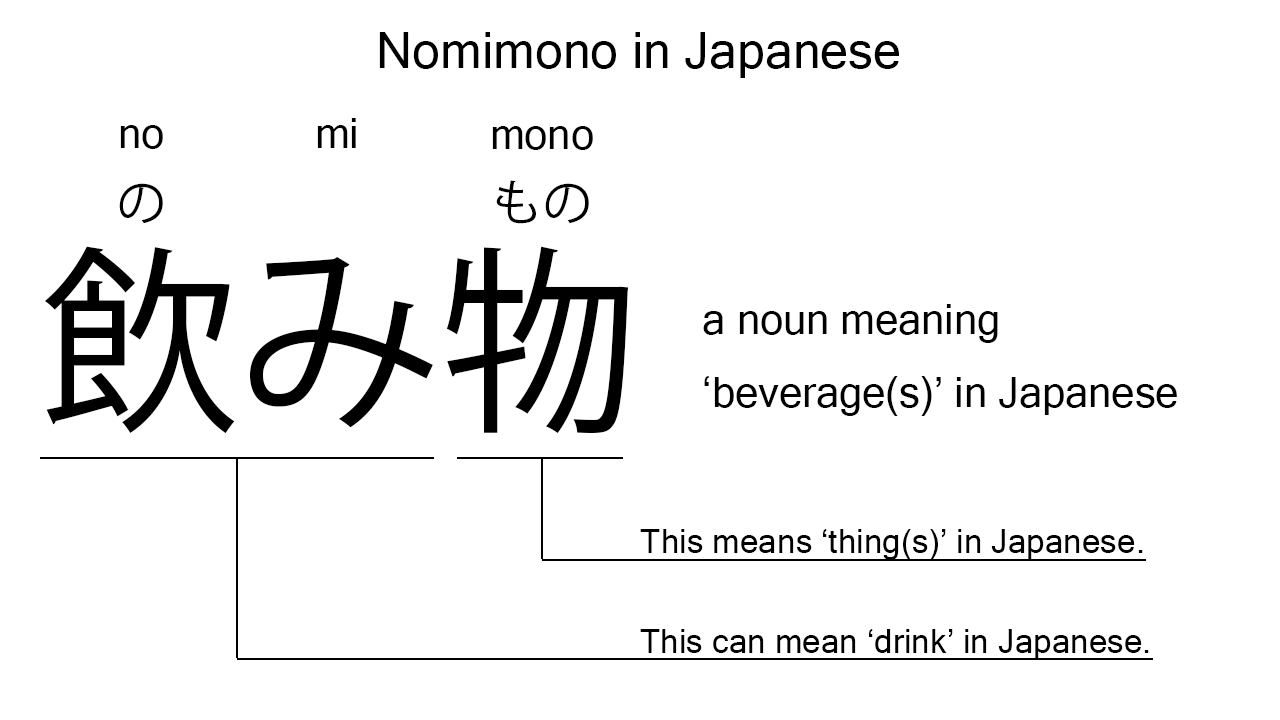What does “nomimono” mean in Japanese?
Native speakers say “nomimono” often to mean ‘beverage’ in Japanese. Perhaps, some Japanese learners know this word as it is sometimes used in Japanese conversations. In this blog post, however, I will explain this word in detail based on its grammatical components. And also, I will explain how to use it through example sentences. My explanations would help Japanese learners understand “nomimono” more clearly. Then, let’s get started!
Contents
Definition and meanings of “nomimono”
Let me start with the definition and meanings of “nomimono”.
- nomimono – 飲み物 (のみもの) : a noun meaning ‘beverage’, ‘drink’, or ‘something to drink’ in general in Japanese. This can also work as plural. Learn more about Japanese plural.
The definition and meanings are not that difficult, I think. To understand this noun more clearly, however, let me explain its grammatical components in detail, one by one.
What does “nomimono” literally mean in Japanese?
“Nomimono” consists of the following two components:
- nomi – 飲み (のみ) : one conjugation of the verb, “nomu“, which means ‘to drink’ in Japanese.
- mono – 物 (もの) : a noun meaning ‘thing’, ‘stuff’, or such in Japanese. Depending on the word used together, this can also mean ‘something’ or ‘anything’ in Japanese. This kanji can also be found in other words like “tabemono” and “kudamono“.
From these two components, we can understand that “nomimono” literally means ‘things to drink’ in Japanese. This literal interpretation is very close to the actual meanings.

When we meet new Japanese words, we should check their grammatical components in detail to understand their meanings clearly and deeply. In many cases, components tell us a lot about the meanings of the words they form. Actually, here, we could get the better understanding of “nomimono” through the detailed kanji check above.
So far, I’ve explained the definition and meanings of “nomimono” together with its grammatical components. Then, let me explain how to use it through the example sentences below.
Example #1: how to say “beverages” in Japanese
kanojo wa amai nomimono ga suki desu – 彼女は甘い飲み物が好きです (かのじょはあまいのみものがすきです)
She likes sweet beverages.
Below are the new words used in the example sentence.
- kanojo – 彼女 (かのじょ) : a pronoun meaning ‘she’ in Japanese.
- wa – は : a binding particle working as a case marker or topic marker. In the example, this works after “kanojo” to make the subject in the sentence.
- amai – 甘い (あまい) : an i-adjective meaning ‘sweet’ in Japanese.
- ga – が : a case particle used to make the subject word or the object word in a sentence. In the example, this is used after “amai nomimono” to make the object in the sentence.
- suki – 好き (すき) : the stem part of the na-adjective, “sukina”, which means ‘favorite’ in Japanese. Native speakers, however, often use this as an individual word to mean ‘to like’ or ‘to love’ in Japanese. In the example, this is used to mean ‘to like’.
- desu – です : an auxiliary verb used after a noun or adjective to make it polite. Probably, this is well known as a part of Japanese desu form. In the example, this is used after “suki” to make it sound polite.
This is a typical usage of “nomimono”. In this example, it works as a part of the noun phrase, “amai nomimono”, which means ‘sweet beverages’ in Japanese.
Example #2: another usage of “nomimono”
watashi wa ano mise de nomimono wo kai tai – 私はあの店で飲み物を買いたい (わたしはあのみせでのみものをかいたい)
I want to buy a drink at that shop.
Below are the new words used in the example sentence.
- watashi – 私 (わたし) : a pronoun meaning ‘I’ in Japanese.
- ano – あの : a determiner used before a noun which refers to something not close to the speaker. In the example, this is used before “mise” to say “that shop” in Japanese.
- mise – 店 (みせ) : a noun meaning ‘shop’ in Japanese. This can also work as plural.
- de – で : a case particle used to say where someone does something. In the example, this is used after “ano mise” to say where the speaker wants to buy a drink.
- wo – を : a case particle used to make the object word in a sentence. In the example, this is used after “nomimono” to make the object in the sentence.
- kai – 買い (かい) : one conjugation of the verb, “kau“, which means ‘to buy’ in Japanese. In the example, it has been conjugated for the better connection with its following word.
- tai – たい : an auxiliary verb used after a verb to make its desire form. In the example, this is used after “kai” to make its desire form, “kai tai”, which means ‘to want to buy’ in Japanese.
This is another typical usage of “nomimono”. When we want to say “drink”, “beverage”, or “something to drink” in Japanese, this noun is always a very good option.
Summary
In this blog post, I’ve explained the definition and meanings of “nomimono” in detail based on its grammatical components. And also, I’ve explained how to use it through the example sentences. Let me summarize them as follows.
- nomimono – 飲み物 (のみもの) : a noun meaning ‘beverage’, ‘drink’, or ‘something to drink’ in general in Japanese. This can also work as plural. This consists of “nomi” and “mono” which mean ‘to drink’ and ‘things’ respectively in Japanese. So, this noun literally means ‘things to drink’ in Japanese. This literal interpretation is very close to the actual meanings.
Hope my explanations are understandable and helpful for Japanese learners.